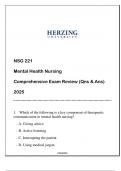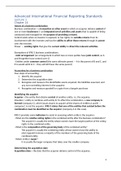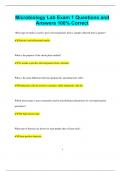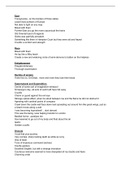PROBLEM 6
How do you negotiate a crisis?
Wells, Taylor & Giebels (2013)
Crisis negotiation is a law enforcement technique used to communicate with people who are
threatening violence (suicide, terrorism, domestic violence).
- Various phase paradigms such as the Michigan State Police Model and Behavioural Change
Staircase Model have been proposed as effective interventions during crises
- Importantly, these various paradigms draw upon 4 stages of interaction that are crucial to
successfully resolving any crises:
1. During the first impressions phase it is important for the negotiator to focus on (a)
conversational engagement, (b) prosodic emphasis, and (c) vocal mirroring, to re-shape the
role dynamic as one of ‘moving together rather than against’. The negotiator should avoid
making assumptions and focus on the act instead of suggesting an underlying motivation.
He should also choose his words carefully and be prepared for a face attack.
2. This then allows negotiators to focus on active listening techniques and mimicry to build
rapport with the perpetrator. The Metropolitan Police Service advocates the use of 3 active
listening techniques to facilitate rapport, these being:
a) focused listening (close attention to the perpetrators speech),
b) responsive listening (ensuring the perpetrator can finish their thoughts), and
c) minimal encouragers (the use of ‘ok’ and ‘go on’ to demonstrate attention).
This in conjunction with the mimicry technique (where negotiators match the speech patterns,
facial expressions, and mannerisms of the perpetrator,) aid negotiators in dissipating
emotion and confrontation. Such techniques reinforce the importance of language choice
and active listening.
3. Sensemaking refers to conceptual accounts that provide frameworks for helping
negotiators make sense of the perpetrator’s actions. The Cylinder Model theorises that
there are 9 communicative frames for understanding any crisis interaction.
Perpetrator motivations are characterised as either:
a) Substantive – use of bargaining power to request something (hostage situation); this
is an instrumental motivation
b) Protection of self-identity (shame); and
c) Relational
A perpetrator can pursue each of these instrumental goals by adopting either an:
a) Avoidant orientation – retracts from substantive discussion
b) Competitive orientation – attacking the other party’s position or credibility; and
c) Cooperative orientation – concessions and compliments
1
, It is important for negotiators to “align their framing of the incident with that of the
perpetrator” as focussing on an inappropriate frame may make the perpetrator feel
misunderstood.
4. It is ultimately necessary for negotiators to dissuade perpetrators from continuing their
course of actions. This can be achieved by adopting various influence skills. The Table of
Ten distinguishes between relational tactics (being kind, being credible, being equal) and
content tactics (emotional appeal, intimidation, imposing a restriction, direct pressure,
legitimising, exchanging, rational persuasion). These tactics are used to move perpetrators
through the aforementioned frames and prevent their course of action.
What is restorative justice and how effective is it?
Wong (2016) Can At-Risk Youth Be Diverted from Crime? A Meta-Analysis of Restorative Diversion Programs
- Due to the large problem of overpopulation in prisons, diversion programs (=eligible offenders
are diverted from traditional correctional facilities to serve their sentences in non-institutional
settings) are thought to reduce the incarceration rate as well as recidivism.
- One form of diversion programs are restorative justice programs. The participation in these
programs is voluntary for offender & victim(s), includes some form of mediation between the
offender and the victim(s) of his crime, and requires the offender’s admission of guilt for his
crime.
� RJ programs see crime as a violation of people & interpersonal relationships rather than
merely a violation of law, and these violations create obligations/ liabilities. RJ attempts to
remedy wrongs caused by criminal behavior. The different RJ programs can differ in
approach, nature of proceedings, and the involvement of victims compared to traditional
criminal justice.
� RJ programs are based on the principles of
⮚ Reintegrative shaming (=expression of disapproval of the offender’s actions by
community, followed by re-acceptance of offender in community; avoids stigmatisation/
labeling; more likely to engage in prosocial behaviors & desist from future crime) and
⮚ Procedural justice (=perception of legitimacy of criminal justice system; individuals who
view the justice system process as fair & legitimate are more likely to obey the law)
� There are 3 intervention models that all include dialogues between victim and offender to
discuss the offense and reach some form of agreement on how to repair the damages.
⮚ Victim-offender mediation: victim and offender may begin the process by meeting the
facilitator first individually; if both parties agree to meet for face-to-face mediation,
then the trained facilitator mediates conversation
2
How do you negotiate a crisis?
Wells, Taylor & Giebels (2013)
Crisis negotiation is a law enforcement technique used to communicate with people who are
threatening violence (suicide, terrorism, domestic violence).
- Various phase paradigms such as the Michigan State Police Model and Behavioural Change
Staircase Model have been proposed as effective interventions during crises
- Importantly, these various paradigms draw upon 4 stages of interaction that are crucial to
successfully resolving any crises:
1. During the first impressions phase it is important for the negotiator to focus on (a)
conversational engagement, (b) prosodic emphasis, and (c) vocal mirroring, to re-shape the
role dynamic as one of ‘moving together rather than against’. The negotiator should avoid
making assumptions and focus on the act instead of suggesting an underlying motivation.
He should also choose his words carefully and be prepared for a face attack.
2. This then allows negotiators to focus on active listening techniques and mimicry to build
rapport with the perpetrator. The Metropolitan Police Service advocates the use of 3 active
listening techniques to facilitate rapport, these being:
a) focused listening (close attention to the perpetrators speech),
b) responsive listening (ensuring the perpetrator can finish their thoughts), and
c) minimal encouragers (the use of ‘ok’ and ‘go on’ to demonstrate attention).
This in conjunction with the mimicry technique (where negotiators match the speech patterns,
facial expressions, and mannerisms of the perpetrator,) aid negotiators in dissipating
emotion and confrontation. Such techniques reinforce the importance of language choice
and active listening.
3. Sensemaking refers to conceptual accounts that provide frameworks for helping
negotiators make sense of the perpetrator’s actions. The Cylinder Model theorises that
there are 9 communicative frames for understanding any crisis interaction.
Perpetrator motivations are characterised as either:
a) Substantive – use of bargaining power to request something (hostage situation); this
is an instrumental motivation
b) Protection of self-identity (shame); and
c) Relational
A perpetrator can pursue each of these instrumental goals by adopting either an:
a) Avoidant orientation – retracts from substantive discussion
b) Competitive orientation – attacking the other party’s position or credibility; and
c) Cooperative orientation – concessions and compliments
1
, It is important for negotiators to “align their framing of the incident with that of the
perpetrator” as focussing on an inappropriate frame may make the perpetrator feel
misunderstood.
4. It is ultimately necessary for negotiators to dissuade perpetrators from continuing their
course of actions. This can be achieved by adopting various influence skills. The Table of
Ten distinguishes between relational tactics (being kind, being credible, being equal) and
content tactics (emotional appeal, intimidation, imposing a restriction, direct pressure,
legitimising, exchanging, rational persuasion). These tactics are used to move perpetrators
through the aforementioned frames and prevent their course of action.
What is restorative justice and how effective is it?
Wong (2016) Can At-Risk Youth Be Diverted from Crime? A Meta-Analysis of Restorative Diversion Programs
- Due to the large problem of overpopulation in prisons, diversion programs (=eligible offenders
are diverted from traditional correctional facilities to serve their sentences in non-institutional
settings) are thought to reduce the incarceration rate as well as recidivism.
- One form of diversion programs are restorative justice programs. The participation in these
programs is voluntary for offender & victim(s), includes some form of mediation between the
offender and the victim(s) of his crime, and requires the offender’s admission of guilt for his
crime.
� RJ programs see crime as a violation of people & interpersonal relationships rather than
merely a violation of law, and these violations create obligations/ liabilities. RJ attempts to
remedy wrongs caused by criminal behavior. The different RJ programs can differ in
approach, nature of proceedings, and the involvement of victims compared to traditional
criminal justice.
� RJ programs are based on the principles of
⮚ Reintegrative shaming (=expression of disapproval of the offender’s actions by
community, followed by re-acceptance of offender in community; avoids stigmatisation/
labeling; more likely to engage in prosocial behaviors & desist from future crime) and
⮚ Procedural justice (=perception of legitimacy of criminal justice system; individuals who
view the justice system process as fair & legitimate are more likely to obey the law)
� There are 3 intervention models that all include dialogues between victim and offender to
discuss the offense and reach some form of agreement on how to repair the damages.
⮚ Victim-offender mediation: victim and offender may begin the process by meeting the
facilitator first individually; if both parties agree to meet for face-to-face mediation,
then the trained facilitator mediates conversation
2










